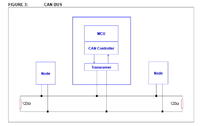ChansAlive
Member level 3

Hi
I want to communicate to the ECU of a vehicle to display few information on an LCD. I want to interface through CAN. I'm thinking to use PIC microcontroller. Also I'm in privilage to program the ECU too. Can anyone suggest me a possible low cost implementation? Also please help me how to transmit and recieve information through CAN.
Hope someone could help...
I want to communicate to the ECU of a vehicle to display few information on an LCD. I want to interface through CAN. I'm thinking to use PIC microcontroller. Also I'm in privilage to program the ECU too. Can anyone suggest me a possible low cost implementation? Also please help me how to transmit and recieve information through CAN.
Hope someone could help...







